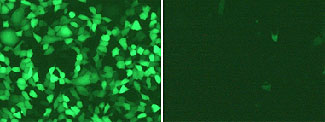Progress in gene therapy

Therapies that include introducing genetic material into target cells require the action of vectors to bind and protect the material from extra and intracellular degradation and to guide it to the final area of expression. In this sense, adenoviruses are the most efficient vectors in the field of gene therapy and also the ones most commonly used in clinical trials with humans. However they do not integrate and in order to obtain a prolonged expression of the therapeutic gene (essential for the treatment of chronic diseases in humans) vectors must be administered in repeated doses, which in the end causes the body to develop an immune response.
To prevent this, last-generation adenoviruses were generated, also called helper-dependent (Ad helper) or gutless (Ad gutless), which remain episomal in the cell and prolong the time of gene therapy expression, in some cases for the duration of the organism's life. The two adenoviruses are used together since Ad gutless, which contains therapeutic properties, does not contain the genetic and protein structure needed for production. The Ad helper in this case administers everything necessary in the production of the Ad gutless, although high immunogenicity is an inconvenience.
Ad gutless was administered in vivo into the tissues of livers, muscles, the central nervous system, retinas, lungs and uterus of animal models such as mice, rats, dogs and non-human primates. It was administered in liver tissues to treat familial hypercholesterolaemia, obesity, ornithine transcarbamylase deficiency, diabetes and chronic viral hepatitis. The positive results obtained in mice, where the therapeutic gene expression was observed to last throughout the life of the animal, led scientists to use these vectors with dogs and non-human primates as a treatment for Haemophilia A and B.
There are numerous advantages in using these vectors. However, clinical trials are not yet possible since none of the existing production methods achieve to reduce the levels of Ad-helper contamination under 1%. Thus there is a need for conceptually new development strategies.
In the article entitled "Differential amplification of adenovirus vectors by flanking the packaging signal with attB/attP-PhiC31 sequences: implications for helper-dependent adenovirus production", published in Virology, 2007 Oct 10;367(1):51-8, Dr Miguel Chillón, ICREA researcher at UAB's CBATEG, and his team describe the development of a new production method based on the generation of an Ad-helper family with the packaging signal flanked with attB/attP DNA sequences of the FC31 recombinant protein.
This modification causes a significant delay in the Ad-helper genome packaging without diminishing its levels of proteic expression or strength. The levels of expansion of these Ad-helpers are 0.001-0.01% with regard to the controls, which demonstrates the large potential of this system in producing Ad gutless without the need of contaminating helpers.
This implies that the method will reduce current levels of Ad-helper contamination by 2 or 3 logarithms, which will in turn make easier up-scale production processes in bioreactors and, for the first time, possible to use Ad gutless in clinical trials with humans.
The results of the study have led UAB to patent this technology (WO/2007/125146, Method for producing adenovirus vectors for gene therapy and DNA sequences used therefor).
References
"Differential amplification of adenovirus vectors by flanking the packaging signal with attB/attP-PhiC31 sequences: implications for helper-dependent adenovirus production." Alba R, Hearing P, Bosch A, Chillon M. (Virology. 2007 Oct 10;367(1):51-8. Epub 2007 Jun 8.)

